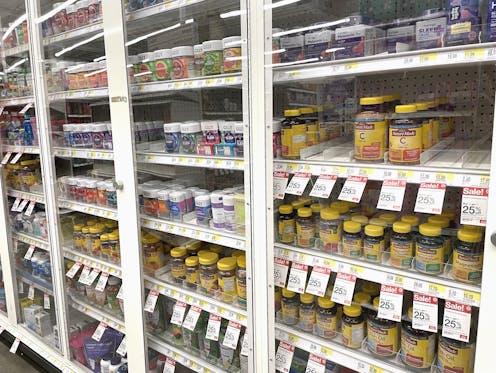Big-box retail chains were never a solution for America's downtowns − and now they're fleeing back t
Shoplifting has been hyped as a driver of chain-store closures, but did these companies ever really understand urban environments in the first place?

Holiday shopping is in full swing, but city dwellers may have fewer options for buying in person than they did a few years ago. That’s because many large chain stores are pulling out of central cities.
This trend has been building for several years. Target made national headlines in 2018 when it closed its store in a predominantly Black Baltimore neighborhood after just 10 years of operation. COVID-19 sped things up by cutting foot traffic in city centers and boosting online commerce.
Target has closed additional stores in Chicago, Milwaukee, New York, San Francisco, Seattle and Portland, Oregon. Walmart, CVS, Rite Aid and Walgreens have also closed many urban stores.
Closures have spread to many suburbs and small towns. Retailers saddled with high debt, overexpansion, shoplifting losses, slumping sales and online competition are shedding stores fast. But this contraction lopsidedly affects city dwellers, who often lack the shopping options and price competition suburbanites enjoy.
Many news reports, particularly from conservative outlets, have blamed lawlessness and weak leadership by progressive city governments. In my view, however, there’s another important factor: flawed corporate strategies.
The self-service revolution
The concept of letting shoppers serve themselves dates back to 1879, when Frank W. Woolworth opened his first store in Utica, New York. Its successors grew into the F.W. Woolworth chain of “five-and-dime” discount dry goods stores, which became fixtures of hundreds of cities, suburbs and small towns in the early 20th century.
Food stores followed suit in the early 1900s, beginning with the Alpha Beta chain in California in 1914 and Piggly Wiggly in Tennessee in 1916. Instead of having clerks gather customers’ orders from store shelves, these stores let shoppers loose in the aisles, then allowed them to pay at the end of their visit.
This approach seeded the meteoric rise of “big box” stores like Walmart and Target in the mid-20th century. With their low manufacturing costs, streamlined logistics, minimally staffed stores, national advertising and vast inventories, big-box chains drove many small retailers out of business – and most Woolworth stores, too.
Self-service came to rule the suburbs, where big chains could build mega-stores with plenty of parking. But they were rare in central cities for most of the 20th century, except for a few affluent enclaves, such as West Los Angeles or Chicago’s North Side. Generally, these chains avoided poor neighborhoods and many downtowns altogether.
As shoppers increasingly gravitated to suburban malls, many urban neighborhoods became retail deserts, with few vendors meeting local needs. Those that endured, often run by small-scale entrepreneurs, typically were businesses that offered a single type of product, such as grocery stores, delicatessens or pharmacies.
Chains discover downtowns
Harvard management professor Michael Porter drew attention to the lack of retail services in densely populated urban neighborhoods in a seminal 1995 article, “The Competitive Advantage of the Inner City.” Economic development, Porter argued, was key to revitalizing inner cities – and these zones housed a lot of potential customers.
“Even though average inner city incomes are relatively low, high population density translates into an immense market with substantial purchasing power,” Porter wrote. “Ultimately, what will attract the inner city consumer more than anything else is a new breed of company that is not small and high-cost but a professionally managed major business employing the latest in technology, marketing, and management techniques.”
Chains of many kinds began to rediscover the central city market in the early 2000s. Tax breaks and subsidized redevelopment projects often greased the wheels. Urban gentrifiers were reliably drawn to new urban chain stores like Target, Walmart and Whole Foods.
Many small retail shops now faced a juggernaut of national chains. One example was independent pharmacies: Between 2009 and 2015, 1 in 4 urban pharmacies in low-income neighborhoods closed.
And chain stores often failed to generate major benefits for their new neighborhoods. Employees had few chances for advancement beyond minimum-wage hourly work. Clustering of chain stores in prosperous neighborhoods and business districts failed to address “food deserts” in impoverished areas.
Broken big boxes
Certain qualities that made chains so successful – national sales strategies, self-service stores and brand awareness – are proving to be liabilities in today’s more complicated and divided urban context.
Retail executives and their trade associations have cited excessive shoplifting losses and weak law enforcement as factors in urban store closures, even though they have conspicuously failed to provide shoplifting data by location. There are signs, moreover, that shoplifting is receding, except for in a few large cities like New York.
In my opinion, there are three reasons why city chain stores are closing at such a high rate compared with those in suburbs.
First, despite job recovery in many cities since the pandemic, low-income urban households remain in crisis, with high rents and inflation driving up the cost of essentials. According to the nonprofit Brookings Institution, 9.6% of suburban residents lived in poverty in 2022, compared with about 16.2% in primary cities. Widespread poverty in a city like Baltimore, for instance, is reflected in the concentration of food banks on the west and east sides.
Less disposable income, compounded by shoplifting losses, can lead to store closures – especially since national chains like Target and Walmart expect the dollar value of sales from stores that have been open for more than a year to increase steadily over time.
Second, urban chains clustered too many of their own branches close together or too near other chains – usually in high-income residential or business districts. Manhattan below 96th Street is a clear example of this pattern. With affluent customers shifting to online shopping, and reduced foot traffic overall thanks to remote work, this aggressive strategy has failed.
Third, widely distributed media images of rampant shoplifting send a message at odds with these chains’ powerful brand images of order, safety and standardization. A small but rising share of shoplifting incidents since 2019 have involved assaults or other crimes. These events have the potential to scare executives concerned about employee lawsuits. Chains want urban locations but not “urban” reputations.
Retail flight
Large retail chains have finally figured out that cities aren’t suburbs. Those that remain are adding staff, scaling back self-checkout, checking receipts at exits and locking down higher-priced goods – essentially, abandoning the self-service model. However, these costly measures won’t bring back online-addicted shoppers or daily commuters, nor will they put more money in struggling consumers’ pockets.
Responding to retail association pressure, some city and state governments are imposing stricter punishments for shoplifting and cracking down on black-market vending on sites like Amazon and eBay. However, it isn’t clear that this get-tough approach can or should rescue the big-box model, since these stores failed to create safe, secure shopping environments in the first place.
As I see it, the urban chain store implosion raises questions about whether suburban-style retail really does much for cities. These stores are mediocre job creators, undercut local entrepreneurs, often pay relatively low property taxes and build ugly parking lots. They also don’t provide the kind of “eyes on the street” local security that small-scale shopkeepers do. In fact, their parking lots and open aisles seem to attract disorder.
Shoehorning suburban-style stores into urban neighborhoods now looks like a Band-Aid for much deeper urban problems. In my view, city leaders would do better to focus on building local capacity and protecting smaller stores that usually have greater local wealth-building potential, more reasonable growth expectations and the kind of personal service that naturally deters shoplifting.
Nicholas Dagen Bloom does not work for, consult, own shares in or receive funding from any company or organization that would benefit from this article, and has disclosed no relevant affiliations beyond their academic appointment.
Read These Next
From record warming to rusting rivers, 2025 Arctic Report Card shows a region transforming faster th
The 20th anniversary of the annual report tracks how sea ice, snow cover and many other vital signs…
The North Pole keeps moving – here’s how that affects Santa’s holiday travel and yours
There are actually two North Poles. One has been wandering over northern Canada and north of there for…
How rogue nations are capitalizing on gaps in crypto regulation to finance weapons programs
North Korea was behind a $1.5 billion digital bank heist in February 2025. Other countries are similarly…





